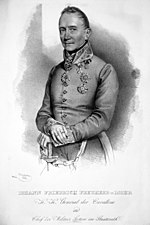Battle of Occhiobello
1815 in Italy1815 in the Austrian EmpireApril 1815 eventsBattles involving AustriaBattles involving the Kingdom of Naples ... and 3 more
Battles of the Neapolitan WarConflicts in 1815Joachim Murat
The Battle of Occhiobello was fought on 8 April – 9 April 1815 and was the turning point of the Neapolitan War. Joachim Murat, King of Naples was repulsed by an Austrian force under the command of Johann Frimont whilst trying to cross the bridge over the Po River at Occhiobello. Following the battle, the Austrians would not lose an engagement for the remainder of the war.
Excerpt from the Wikipedia article Battle of Occhiobello (License: CC BY-SA 3.0, Authors).Battle of Occhiobello
Viadotto Fiume Po, Ferrara
Geographical coordinates (GPS) Address Nearby Places Show on map
Geographical coordinates (GPS)
| Latitude | Longitude |
|---|---|
| N 44.915222222222 ° | E 11.579588888889 ° |
Address
Viadotto Fiume Po
45039 Ferrara
Emilia-Romagna, Italy
Open on Google Maps









